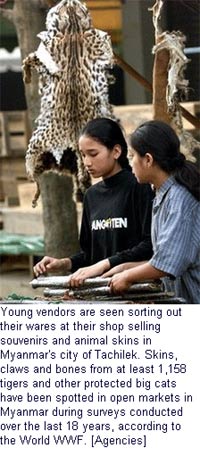
Skins, claws and bones from at least 1,158 tigers and other protected big cats have been spotted in open markets in Myanmar during surveys conducted over the last 18 years, according to a World Wildlife Fund (WWF) report.
More than half came from five species banned from international trade, among them four species listed at threatened with extinction.
The tally included more than 100 tigers, whose numbers in the wild have dwindled to a few thousand worldwide, according to conservation experts.
"This can only be the tip of the iceberg," said Chris Shepherd, who coordinated the investigation carried out by TRAFFIC, a wildlife trade monitoring network supported by WWF.
"The cats were openly displayed for sale and the dealers quite frank about the illegality of the trade, which suggests a serious lack of law enforcement," he said in a statement.
Three of four markets monitored in a dozen surveys -- the most recent in late 2006 -- are located on borders with China and Thailand, with prices quoted in Chinese yuan, Thai baht and US dollars.
Yangon is a signatory to the Convention on International Trade in Endangered Species of Wild Fauna and Flora (CITES), and thus is legally bound by its provisions.
"The sale of endangered cat parts ... is an appalling and brazen violation of the law in Myanmar and should not be tolerated," said Susan Lieberman, director of the WWF's wildlife programme.
"Most of these species have very low population numbers and will not be able to withstand the amount of poaching that is feeding this trade."
Four of the big cats whose parts were for sale figure on the International Union for the Conservation of Nature's (IUCN) Red List as threatened with extinction: the tiger, the clouded leopard, the marbled cat and the Asiatic golden cat.
Along with a fifth, the leopard, they are all banned from international trade by CITES.
While most of the specimens from these five species were found in surveys during the 1990s, more than 120 turned up after 2000, showing that the illegal trade is still going strong, the report concluded.
(China Daily October 15, 2008)